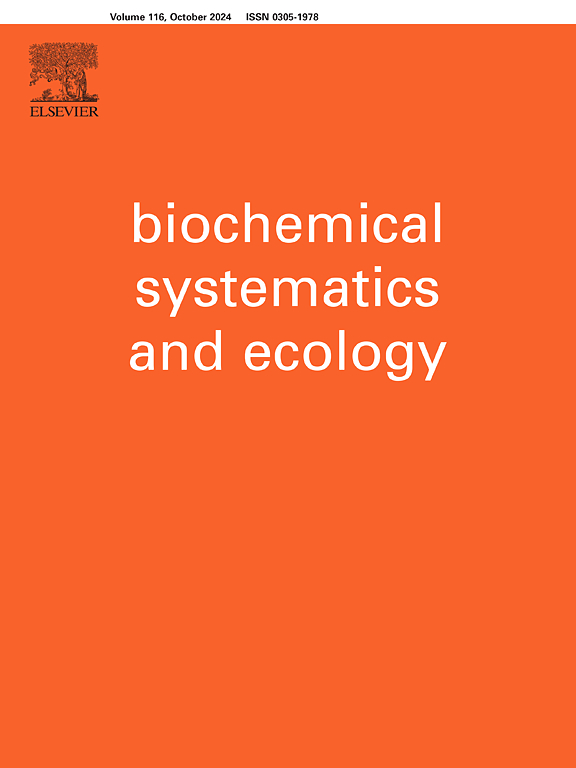诺丽果汁中的化学成分及其化学分类学意义
IF 1.4
4区 生物学
Q4 BIOCHEMISTRY & MOLECULAR BIOLOGY
引用次数: 0
摘要
诺丽果汁是由热带地区的诺丽(Morinda citrifolia L.)果实发酵而成的一种全球知名的健康饮料。)果实的植物化学研究,发现了一种新的香豆素苷,即 esculetin-7-O-β-d-glycopyranosyl-(1 → 6)-β-d-glucopyranoside (1),以及一种新的天然产物 (8) 和 18 种已知化合物:六种香豆素衍生物 (2-7)、两种生物碱 (9 和 16)、六种二酮哌嗪 (10-15)、一种呋喃衍生物 (17) 和三种木脂素 (18-20)。通过大量的核磁共振和 HRESIMS 分析,这些化合物的结构得以阐明。化合物 2 和 8 的核磁共振数据是首次全面报道。此外,还研究了分离出的化合物的化学分类学意义,突出了这些化合物的重要性。值得注意的是,1-4、8-16 和 18 号化合物是首次从巴戟属中分离出来。这些发现有助于加深人们对诺丽果汁化学多样性的了解。本文章由计算机程序翻译,如有差异,请以英文原文为准。

Chemical constituents from noni (Morinda citrifolia L.) fruit juice and their chemotaxonomic significance
Extensive phytochemical investigation on the noni juice, a globally renowned health beverage derived from the fermentation of noni (Morinda citrifolia L.) fruit in tropical regions, led to the discovery of a new coumarin glycoside, esculetin-7-O-β-d-glycopyranosyl-(1 → 6)-β-d-glucopyranoside (1), along with a new natural product (8), and eighteen known compounds: six coumarin derivatives (2–7), two alkaloids (9 and 16), six diketopiperazines (10–15), a furan derivative (17), and three lignans (18–20). The structures of these compounds were elucidated through extensive NMR and HRESIMS analysis. The NMR data of compounds 2 and 8 are reported comprehensively for the first time. The chemotaxonomic significance of the isolated compounds was also examined, highlighting their significance. Notably, compounds 1–4, 8–16, and 18 were being reported from the genus Morinda for the first time. These findings contribute to the growing understanding of the chemical diversity of noni juice.
求助全文
通过发布文献求助,成功后即可免费获取论文全文。
去求助
来源期刊

Biochemical Systematics and Ecology
生物-进化生物学
CiteScore
3.00
自引率
12.50%
发文量
147
审稿时长
43 days
期刊介绍:
Biochemical Systematics and Ecology is devoted to the publication of original papers and reviews, both submitted and invited, in two subject areas: I) the application of biochemistry to problems relating to systematic biology of organisms (biochemical systematics); II) the role of biochemistry in interactions between organisms or between an organism and its environment (biochemical ecology).
In the Biochemical Systematics subject area, comparative studies of the distribution of (secondary) metabolites within a wider taxon (e.g. genus or family) are welcome. Comparative studies, encompassing multiple accessions of each of the taxa within their distribution are particularly encouraged. Welcome are also studies combining classical chemosystematic studies (such as comparative HPLC-MS or GC-MS investigations) with (macro-) molecular phylogenetic studies. Studies that involve the comparative use of compounds to help differentiate among species such as adulterants or substitutes that illustrate the applied use of chemosystematics are welcome. In contrast, studies solely employing macromolecular phylogenetic techniques (gene sequences, RAPD studies etc.) will be considered out of scope. Discouraged are manuscripts that report known or new compounds from a single source taxon without addressing a systematic hypothesis. Also considered out of scope are studies using outdated and hard to reproduce macromolecular techniques such as RAPDs in combination with standard chemosystematic techniques such as GC-FID and GC-MS.
 求助内容:
求助内容: 应助结果提醒方式:
应助结果提醒方式:


